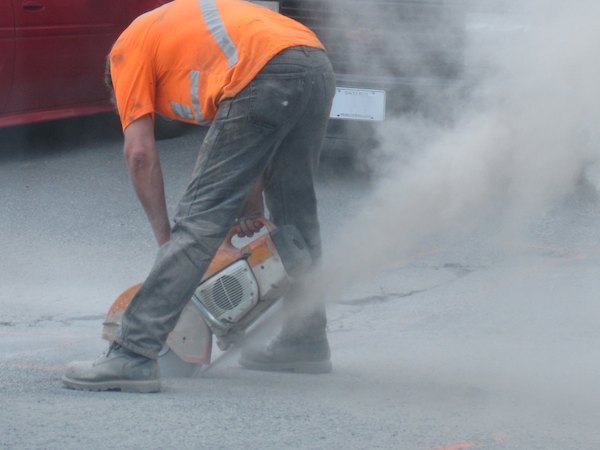
[Image above] Credit: Pat Pilon; Flickr CC BY 2.0
Exposure to inhalable silica dust is a health risk—but that’s not news. Back in 1938, Secretary of Labor Francis Perkins initiated a campaign based on then-known occupational hazards of exposure to inhalable silica dust.
Yet current occupational exposure limits for silica have remained unchanged since the 1970s, even when medical research suggests the limits have been set too high to be safe. Unchanged, that is, until yesterday.
The Department of Labor’s Occupational Safety and Health Administration (OSHA) yesterday issued a ruling that lowers worksite exposure limits of respirable silica by half or more of current limits.
The new ruling sets the new exposure limit for inhalable crystalline silica at 50 μg/m3 of air, averaged over an 8-hour shift. OSHA separated the ruling into two separate standards, one for the construction industry—which previously had an exposure limit of 250 μg/m3—and one for general and maritime industries—which previously had an exposure limit of 100 μg/m3.
In addition to lowering exposure limits, the ruling also requires employers to provide respirators to workers when exposure can’t be adequately reduced; develop a written exposure control plan; offer medical exams to exposed workers; and, among other things, train workers on silica exposure risks and procedures.
According to OSHA, “about 2.3 million workers are exposed to respirable crystalline silica in their workplaces, including 2 million construction workers who drill, cut, crush, or grind silica-containing materials such as concrete and stone, and 300,000 workers in general industry operations such as brick manufacturing, foundries, and hydraulic fracturing, also known as fracking.”
Although we love silica as a material, airborne particles of silica have well-documented negative consequences on human health. Exposure to silica dust can damage the eyes and lungs, causing diseases such as silicosis, lung cancer, kidney disease, and chronic bronchitis.
Although the various negative health consequences of breathing silica dust are well documented, setting precise exposure limits is no simple process.
One reason is that the health hazards of inhaling silica dust often develop over long time frames—often in scales of years, even decades. That type of environmental exposure risk is hard to measure, partially because such long-term controlled experiments are hard to perform. And exposure to countless other factors, agents, and confounders during those long timeframes easily cloud the overall picture, confusing which outcome can be attributed to which variable.
Plus, worksite exposure levels aren’t continuously monitored—while they may be periodically sampled, it’s difficult to pinpoint the exposure level that draws a line between safe and dangerous.
And by the time you factor in the fact that we are each a unique heap of genetically unique cells, the overall landscape of risk is a nearly incomprehensible soup of variables. So the bottom line is that, while there is a ton of data out there that indicates inhalable silica poses a significant risk, there aren’t studies that put a specific consensus number on the exposure limit.
Nonetheless, OSHA thinks that reducing the limits will ultimately help protect workers.
“We’re estimating that once it’s fully in effect it will save about 600 lives a year,” says OSHA director David Michaels in an NPR article about the new ruling. “The rule is also expected to prevent more than 900 cases of silicosis each year.”
Depending on the industry, worksites that expose workers to silica dust have anywhere from one to five years to comply with the new rules, with the shortest compliance time for the construction industry (June 2017) and the longest grace given to hydraulic fracturing (for some sectors, stretched out to June 2021). Find more information on OSHA’s website.
But it seems that some individuals in the affected industries aren’t happy with the new rules.
According to US Glass Magazine, regardless of the new OSHA rule, the glass industry has already taken initiatives regarding silica exposure. “Our industry has already implemented various engineering and work process controls to reduce crystalline silica exposure,” according to Bill Yanek, executive vice president of the Glass Association of North America. “Requiring the flat glass manufacturing industry to completely redesign their operating furnaces and other manufacturing equipment and processes is not merely unreasonable as a matter of policy but also beyond OSHA’s legal authority.”
Some individuals in the construction industry aren’t happy, either. They are concerned the new rules will add significant cost and time delays to construction projects. A study from the Construction Industry Safety Coalition released last year says that implementing the new OSHA rule will cost the construction industry $5 billion per year, whereas OSHA estimates that cost at just $5 million per year.
According to a different article from US Glass Magazine, “OSHA’s crystalline silica proposal is potentially the most egregious regulatory initiative that OSHA has proposed for the construction industry,” says Geoff Burr, vice president of government affairs at Associated Builders and Contractors. “In addition to failing to demonstrate a need for the rule, OSHA has severely underestimated the compliance impact. The proposal likely will impact 1.5 million more construction workers than OSHA estimated and will cost at least four times as much to implement.”
What do you think of the new OSHA rule—overdue or overreaching?
Author
April Gocha
CTT Categories
- Construction
- Environment
- Market Insights


